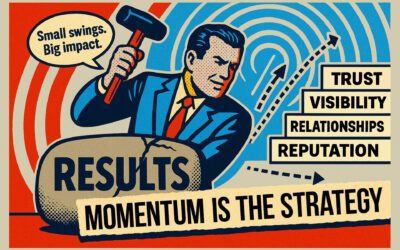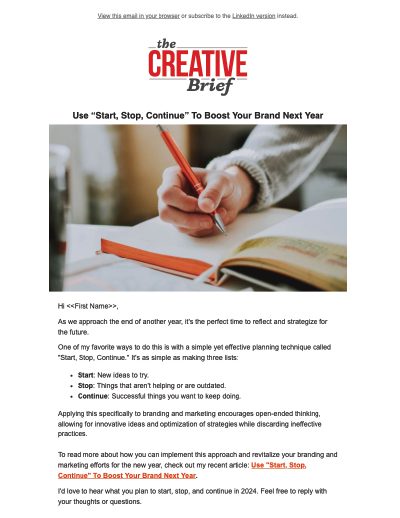Most business owners have an idea of what they want their company to look like. However, their employees can’t necessarily see that same vision for what the future can be.
Surprisingly, few businesses I work with have even one, let alone all four, of the basic strategic statements written down: Mission, Vision, and Value Proposition, and Positioning. What’s more, the few that have just a Mission statement really only have a mash-up hybrid of a Mission and Vision, that’s actually more Vision than anything else.
The Vision statement and Mission statement are often confused, and many companies use the terms interchangeably. However, they each have a different purpose. The Vision statement describes where the organization wants to be in the future; the Mission statement describes what the organization needs to do now to achieve the vision. I explained this more thoroughly in my previous article Getting Mission, Visions, and Values Right.
If you are struggling with writing a clear Mission statement and Vision statement, then you should try to write a Vivid Visionfirst.
Leaning Out Into The Future: Look Ahead 3 Years, And Write As Much As You Can.
If you can pull together ideas of what you want your company to look like, then you can get everybody to see what you can see. Pull these ideas out of your mind, and write it down on a 3 to 5-page document that describes your business three years in the future, with clarity. This is called a Vivid Vision– or painted picture – statement.
If you’re familiar with the Big Hairy Audacious Goal (BHAG) concept – an idea conceptualized in the book, “Built to Last: Successful Habits of Visionary Companies”by James Collins and Jerry Porras – this is similar but more far-reaching in terms of helping you to set your business goals.
Business coach and speaker Cameron Herold first introduced the Vivid Vision idea in his 2011 book “Double Double: How to Double Your Revenue and Profit in 3 Years or Less” and then again in the 2018 follow-up “Vivid Vision: A Remarkable Tool For Aligning Your Business Around a Shared Vision of the Future”, as a way to share your excitement for the future of your company in a clear, compelling, and powerful way.
As Cameron writes: “A Vivid Vision comes about when an entrepreneur, founder, CEO—whatever you call yourself—plants one foot in the present and then leans out and places the other in the future, in the “what could be.”
He finds that three years to be the best period to cover when creating a Vivid Vision. “This timeline is short enough to be seen as realistic and achievable, yet long enough to allow you to realize innovative and expansive ideas.
When you are done writing, you will have a three-four page document describing your vision for what your company will be three years out. This may seem like an easy thing to produce, but it isn’t.
Tips For Getting Started Writing Your Vivid Vision.
When you peer into the future, what do you see? What do you want to be there? What materializes in front of you as the ultimate state of success? One helpful exercise is to imagine that you’re recording every aspect of your business: your employees, customers, supplier relationships, and so on. Play the film in your mind: what do the big picture and the details look like three years out?
Here are some tips for getting all of this out of your head, and onto paper.
Get out of the office.
Try to work anywhere but where you work every day. You’re too likely to get pulled into doing the work of today when you need to be thinking about tomorrow. Even a coffee shop might have too many distractions. Find your quiet place and work from there. For me, that would be at the beach, or up north in the woods (where it’s more relaxed). Either way, I like to sit outside for this kind of work.
Step away from the devices.
Even if you really love writing on your computer, I suggest using a pen and paper. There is something about scribbling notes, making lists, and sketching ideas that help get the big ideas out. Consider this a rough first draft. You can always clean it up on the PC later. Also, turn off your phone. Resist the urge to check your email or social media accounts. These distractions will just pull you into the present.
Think about “Where” not “How.”
Don’t focus on how you’re going to make any of this happen. Focus only on where you want to be in three years. You can figure out how you’ll accomplish all of this later.
Think outside the box (don’t groan).
Even if you don’t think you’re creative, there are ways to get the creative juices flowing. Try thinking about something too crazy to share with anyone, or take seriously. An excellent tool for this is mind-mapping, which allows you to brainstorm without having to provide explanations of strategies for achieving the desired goal. Here’s a good rule to follow: if what you think about during writing seems crazy or unlikely, it is definitely something you want to include.
Cover every area of your business: culture, staff, marketing, public relations, sales, IT, operations, finance, production, communication, customer service, engineering, values, employee engagement, work-life balance, etc. Cover interactions you’ll be having with all stakeholders, too. Remember that you are envisioning all these aspects of your company after it has grown.
Using Your Vivid Vision
When you’re done writing, you’ll have roughly three pages that describe what you envision your company will look and feel like in three years. But it won’t go into any detail about how each part of that vision itself will get put into action. It describes what the future looks like, not how you’ll get there.
With this description of the future in hand, you’ll now be equipped to “reverse engineer” your success. Share your vivid vision with your employees and stakeholders – the people who you work with, who will help you get where you’re going.
As a result, employees will incorporate this blueprint for the future into their overarching and day-to-day goals. They will enthusiastically strive for the picture of an even more successful future you have painted for them.
Cameron Herold even suggests having your top employees reread the vivid vision throughout the year, circling key words or phrases that resonate with them. The go around the room and have each person areas aloud the areas they circled. This exercise can provide alignment for the whole team before a strategy brainstorming session, and it is a useful tool to assist you in planning and prioritizing future projects.
You can start planning the “how” with strategies to reach those goals, and develop the tactics you can use make it all happen. Over time, your company’s decision making will start aligning with your Vivid Vision.




